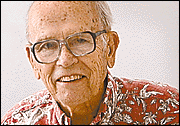


Hawaii’s World
THE process of working out the political future of Hawaiians in Hawaii will move an important step forward Saturday. That will be the official opening of the Native Hawaiian Convention with a swearing-in of 77 delegates at noon at Iolani Palace. The Native
Hawaiian ConventionAt a press conference two weeks ago it was suggested the delegates could take as long as seven years to wrap up their work.
One of the early things they will do after organizing is to boost their membership to 85, by filling the eight vacancies left in their low-turnout election Jan. 17.
For the long term they expect to divide into committees or task forces to weigh the many possible aspects of what "Hawaiian sovereignty" should be -- from declaring independence from the U.S. (unlikely) to some sort of "state within a state" governance by Hawaiians for Hawaiians.
There is a lot to wrestle with including the blood quantum to be called Hawaiian -- now 50 percent for the Hawaiian Homes program but any percentage for voting to elect trustees of the Office of Hawaiian Affairs.
OHA, child of the 1978 state constitutional convention, is a first substantial step toward Hawaiian governance. It is seen as inadequate by many because the state has too much say over it.
It has, however, over $300 million in assets and is seeking another $300 million in land or cash as reparations for lands taken from the Hawaiian monarchy. That settlement conceivably could free it from state financing entirely.
Couple OHA with the Hawaiian Home Lands Department (200,000 acres) and an entity emerges that if wrapped into a "state within a state" could be quite powerful.
This is without regard to the giant 370,000-acre Bernice P. Bishop Estate, dedicated to the education of Hawaiian children through the Kamehameha Schools and valued in the vicinity of $10 billion.
It is also without regard to other trusts benefiting Hawaiians that bring the total of lands with Hawaiian beneficiaries to about 22.7 percent of all the lands in the state, by a calculation I made in 1996.
Standing against the Native Hawaiian Convention is Ka Lahui, claiming some 20,000 members. It wrote its own constitution in 1987 and has revised it twice since. Ka Lahui boycotted the Native Hawaiian Convention election and claims responsibility for the low turnout (8 per cent of all ballots sent out) but offered no opposition slate to test its strength.
THE Native Hawaiian Convention is backed by 10 Hawaiian groups. It has a varied list of delegates, many of them very substantial figures in Hawaiian affairs like Myron Thompson, former Bishop Estate trustee; Dante Carpenter, former OHA administrator and mayor of the Big Island; and Momi Cazimero, former University of Hawaii regent.
It also has such prominent Hawaiian activists as "Bumpy" Kanahele, Hayden Burgess and Charles Maxwell.
To get out from under any stigma of being a "tool" of the state (whatever that is) delegates are paying their own expenses. They have financed their very professional organizational and public relations effort with private funds.
OHA has announced that it will hold a puwalu, or coming-together, discussion for all Hawaiians in October to also address the meaning of "sovereignty." If that would bring Ka Lahui under the same tent as the Native Hawaiian Convention delegates it could be interesting indeed. There is talk now of delaying the puwalu until mid-2000.
A.A. Smyser is the contributing editor
and former editor of the the Star-Bulletin
His column runs Tuesday and Thursday.